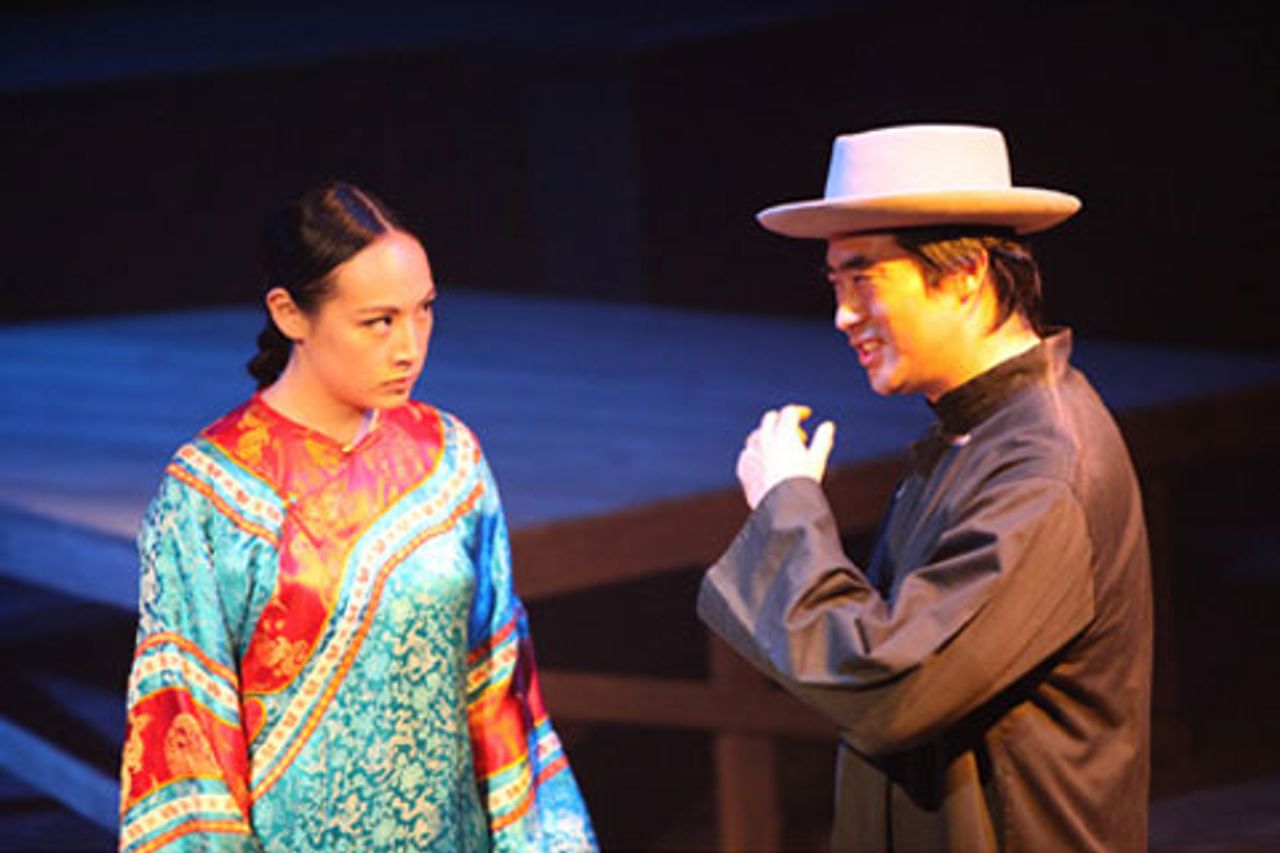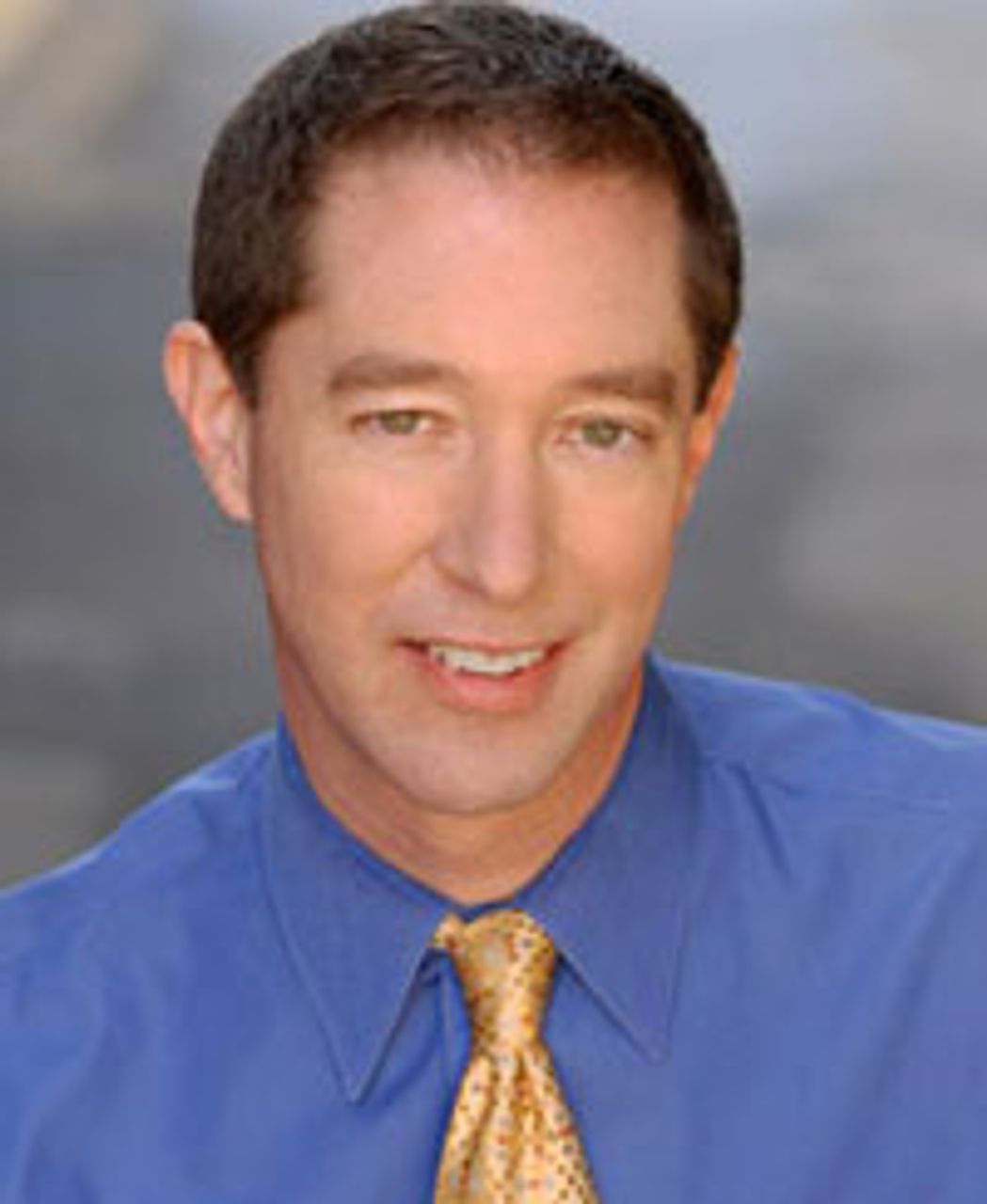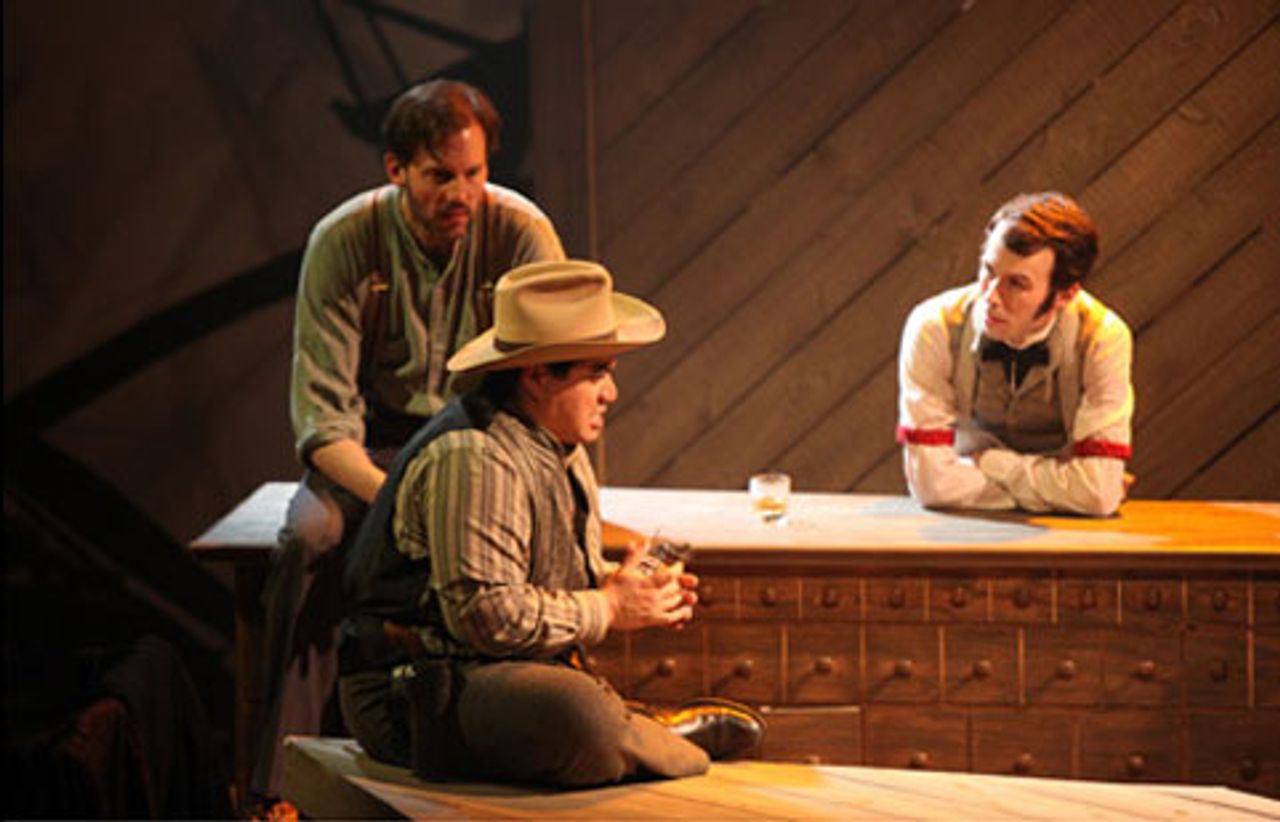 Elizabeth Ho and Ryun Yu [Photo by Shane William Zwiener]
Elizabeth Ho and Ryun Yu [Photo by Shane William Zwiener]Ensemble Studio Theatre, The L.A. Project recently presented the world premiere of two plays by Tom Jacobson: The House of the Rising Son, helmed by Michael Michetti, closes June 12. The other, under Jeff Liu’s direction, was The Chinese Massacre (Annotated). It closed May 28.
The second piece, the subject of this review, lies somewhere between messy masterpiece and masterful mess. Liu has staged it with aesthetic precision. The ensemble of fourteen actors playing thirty-some roles is impeccable. The play’s purported subject is the murder of seventeen Chinese men by a white lynch mob and the burning of Los Angeles’s Chinatown in the autumn of 1871. Its deeper and more problematic subject, however, is the nature of history itself.
 Tom Jacobson
Tom JacobsonJacobson uses his play to wrestle with several historiographical questions: how events are recorded and transmitted, who has written about them, for whom, and why; and how lacunae in the historical record are filled with such objective data as census figures and property records, as well as fabrications, lies, half-truths, willful omissions, and spin.
Years after the events of 1871, Mr. Lee (West Liang), a well-dressed, well-spoken Chinese gentleman from San Francisco, approaches Reverend “Curly” Crenshaw (Silas Weir Mitchell) and offers to purchase the severed finger of a Chinese man. Their haggling over price is Lee’s pretext for learning how it came into Crenshaw’s possession. Over the course of numerous scenes, we learn that Lee is in fact the brother of Dr. Wong Tuck (Ross Kurt Le), the victim of mutilation and murder. We learn that Lee wants to bury the finger so as to uphold the Chinese custom of jup gam, literally “picking the gold”: bones are exhumed, cleaned, and returned to China for burial among one’s ancestors.
By play’s end, Lee confirms his initial suspicions: that during the riot, a white mob had set upon his brother, shot him to death, looted his body, and cut off his finger. Crenshaw had performed this last act to get the ring on which it was stuck. [For an excellent summary of current research and understanding of the events of 1871, see ‘The Chinese Massacre,’ LA Weekly, March 11-17, 2011, by John Johnson, Jr., and a recent study by historian Scott Zesch.]
 Silas Weir Mitchell, Richard Azurdia and Alex Levin [Photo by Shane William Zwiener]
Silas Weir Mitchell, Richard Azurdia and Alex Levin [Photo by Shane William Zwiener]Rather than tell the story of this atrocity in straightforward narrative fashion, Jacobson builds perspectives on a collage of shifting events that casts doubt on the reliability of any historical interpretation. The parenthetical “(Annotated)” in the title forewarns us that presentation of this story will be peppered with supporting “footnotes,” cheekily delivered by members of the ensemble in direct address. The effect is at times provocative, and at other times hopelessly confusing; the “annotators” interrupt the action to provide snippets of information and identify its sources: editorials, speeches, newspaper accounts.
For the most part, these vocal “footnotes” resemble those found in a scholarly paper. Commenting on the events on stage, they clarify, contradict, and even prove disorienting with their anachronisms. They create confusion, coming at the audience with an annoying frequency that rudely takes the audience out of many of the play’s emotional moments. If this technique denies us the possibility of heartfelt sympathy, it is intended.
In an early interjection, the tart Annotator (Lisa Tharps) offers a short description of Bertolt Brecht’s “alienation effect.” In that German playwright’s hands, it was a calculated style of storytelling; it emotionally distances us from the events portrayed on stage to force us to use “the head, not the heart.” Unfortunately, the approach here turns Brecht’s dramaturgical theory into something trivial. At its best, Brecht’s genius allowed us to experience the drama of characters in conflict and duress while always and simultaneously providing a broader political and historical perspective on their existence.
In his other plays (such as his House of the Rising Son), Jacobson shows that he is quite capable of creating emotionally engaging scenes peopled by deeply sympathetic, complicated characters. But in The Chinese Massacre he has chosen to alienate his audience to the point that it cannot trust the way events are portrayed even in his own play. It’s a daring theatrical choice, but ultimately, a frustrating one.
In a play about justice, we want to witness justice served or frustrated in ways that fuel our anger or knowledge. In a play about historical “truth,” we want to come away from the experience somewhat assured that we know what “really” happened that night in 1871. Jacobson seems to be saying that justice and historical truth are chimera, unknowable. The result leaves us more addled than enlightened, like all such postmodernist efforts.
The final moments of the play present us with certain icons of Los Angeles’s history—a fist-raised Angela Davis, a zoot-suited Chicano, an echo of Rodney King pleading, “why can’t we all get along?” They appear almost as exhibits, afterthoughts to the story. Having schooled us in distrust, these icons are doomed to the banality of sound bites. The relativism that pervades the play sabotages its own final call for togetherness and mutual understanding, which, in any case, in a society ravaged by ever-widening social antagonisms, is an empty, liberal dream.
In interviews, Mr. Jacobson has insisted he does not have a political agenda. By drawing attention to parallels between the anti-Chinese riot of 1871, the Zoot Suit riots of 1943, the Watts riots of 1965, the Rodney King riot of 1992, and ongoing intramural conflicts among LA’s ethnic communities, he merely wants us to ask why these racial and ethnic tensions persist in the City of the Angels. He recently told LA Stage Times (April 20, 2011): “I want people to think about it and do their own examination. Can they just sit in judgment and say we’re better than that now or that’s not me?”
The play treats racism as a disease like the syphilis that kills Yut Ho and blinds Crenshaw. A playwright is not obliged to offer thorough explanations for the events he or she represents. However, in a dramatic piece that treats a significant and troubling historical episode, it would seem incumbent on the writer to go into things more deeply than Mr. Jacobson has done in the present case. To present the history of the US or Los Angeles merely as a series of ethnic conflicts is one-sided enough to be seriously misleading.
The anti-Chinese pogrom of 1871 was bound up with post-Civil War economic developments and efforts to divert attention from the division that would come to dominate American life, the struggle between the classes, into reactionary channels.
During the 1860s, nearly half the Chinese population in the United States worked for the Central Pacific Railroad under brutal conditions. Once the transcontinental railroad was completed, two-thirds of its Chinese labor force returned to China; the rest went into fishing and agriculture, many signing labor contracts to work the former plantations of the Old South (replacing slave labor) while others migrated to frontier cities such as Los Angeles.
Sections of white immigrant workers, led by demagogues, were led to perceive these abruptly unemployed Chinese workers as a threat. More telling than quoting the laughably prejudiced editorial pages of the Los Angeles newspapers would have been a reference to Denis Kearney’s speech to ten thousand unemployed workers in San Francisco in 1877—when the fictional Lee Tong would have been living in San Francisco. At that rally to support striking East Coast railroad men, Kearney railed against the railroad magnates and big landowners. He reserved his most venomous attacks, however, for the Chinese workers, whom he accused of stealing “American” jobs.
Kearney called upon the crowd to expel them from the country by force. Within minutes of his cry, “The Chinese must go!”—which became the battle cry of the American Workingmen’s Party—a white mob rampaged through San Francisco’s Chinatown for three days, beating the men and gang-raping the women. They burned laundries and attacked the steamship docks that provided transport to China. This would have been Lee Tong’s backstory.
Anna Smith, chair of the Workingmen’s Committee, defended the mob’s actions, comparing them to the Minutemen of Lexington. She asserted that it was “a mob that threw the tea overboard in Boston Harbor” and ended her oration with, “I want to see every Chinaman thrown out of this state.” Kearney fantasized exploding dynamite-loaded balloons over Chinatown and erecting gallows on every vacant lot.
Samuel Gompers, president of the American Federation of Labor, painted the Chinese as liars, cheaters, murderers and opium addicts. He even insisted that Chinese men had left their wives at home so they could prey on virtuous American girls (overlooking the fact that most Chinese women were legally prohibited entry into the United States). Henry George warned that Chinese immigration would “make the rich richer and the poor poorer” and that they would make “princes of our capitalists and crush our working class into the dust.”
This Yellow Peril hysteria climaxed in the atrocities of 1885-1886: in Rock Springs, Wyoming, in Issaquah, Tacoma, and Seattle, Washington, and in Juneau, Alaska, where a hundred Chinese men were set adrift at sea. California had its own Klan-like “Order of Caucasians”; it waged a relentless campaign to terrorize the Chinese. In 1885 alone, thirty-five California communities experienced anti-Chinese riots or forced expulsions.
But this is not the end of the story. The disastrous impact of nativism and anti-immigrant chauvinism was brought home to the most class-conscious elements in the American working class. Figures such as Daniel DeLeon of the Socialist Labor Party and Bill Haywood of the Industrial Workers of the World (IWW) fought tirelessly against racism and for class solidarity.
In 1906, DeLeon, for example, wrote: “Socialism knows not such insulting, iniquitous distinctions as ‘inferior’ and ‘superior’ races among the proletariat. It is for capitalism to fan the fires of such sentiments in its scheme to keep the proletariat divided.”
The IWW as a whole was characterized by a hostility toward anti-Asian and anti-immigrant chauvinism. As the Industrial Worker explained in 1912, “A worker who proclaims himself class conscious and then talks loftily about ‘greasers’, ‘dagoes’, ‘coons’, etc. is a fool. He is really nothing but race conscious... The worker has no nation to protect. The nations belong to the masters.” The consequences of socialist opposition to racism and chauvinism found fruit, for example, in the wide support for the struggle to defend Sacco and Vanzetti, two Italian immigrant workers framed up in 1920.
While these issues may seem outside the purview of this play, Jacobson samples material for his “footnotes” from other times and places to illustrate the pervasiveness of anti-Chinese racism. Thus, it is a choice by the playwright not to annotate the Los Angeles Chinese Massacre of 1871 with reference to material economic conditions or class relations, or subsequent events. He avoids the deeper truth of racism as a weapon to divide the working class in service of bourgeois and propertied interests, preferring instead to tug at our hearts by presenting Dr. Wong, Wong Tuck’s wife, and Lee Tong, as “good” Chinese, i.e., the assimilated petty bourgeoisie, unfairly victimized.
Jacobson rightly fuels our outrage at the racially myopic murder and mutilation of the good Dr. Wong, but then he avoids examination of the conditions that created that mob. Jacobson’s purpose may have been simply to draw our attention to a forgotten moment in the history of Los Angeles and to sensitize those of us who live in L.A. that these racial tensions and the vigilantist impulses have long been with us and continue to percolate in the world’s most culturally diverse megacity. But given his source material, Jacobson could have dug deeper than skin tone and reached further than pop analogy.
The Chinese Massacre (Annotated) is a cautionary tale whose teeth are unfortunately blunted and sinews softened by too much postmodern relativism. It forcefully reminds us that American history can be ugly, but shies away from exploring why.
The physical production—the set, lights, costumes, and sound—is as good as it gets in live theatre. Sibyl Wickersheimer’s scenic design, with its raw wood panels and slightly skewed platforms, evokes a frontier town still under construction while hinting at the interior of a Chinese apothecary. Her backdrop of exaggerated Chinese “grass” painting, black on white representations of bamboo wrapping onto the theatre’s side walls, conjures a sense of Chinese culture being smothered by new makeshift building, drawing attention to the ephemerality of both. Dennis Yen’s sound design evokes a palpable world; Dianne Graebner’s costumes are spot-on, as is Thomas Ontiveros’ lighting design, especially in capturing the great fire that dominates the mob’s frenzied assaults.
Director Jeff Liu’s stage choreography and especially his staging of crowd scenes, the bane of big-cast productions, is deft, energetic, and riveting. The acting, in both its presentational and more realistic moments, was exceptional, specific, and captivating. West Liang and Lisa Tharps are standouts in this uniformly talented ensemble.
